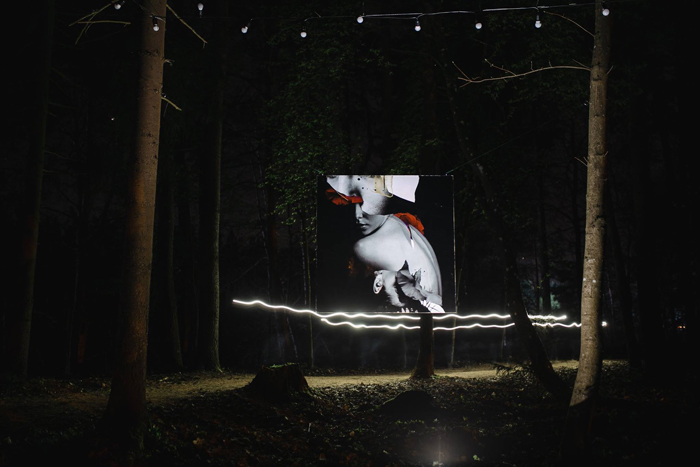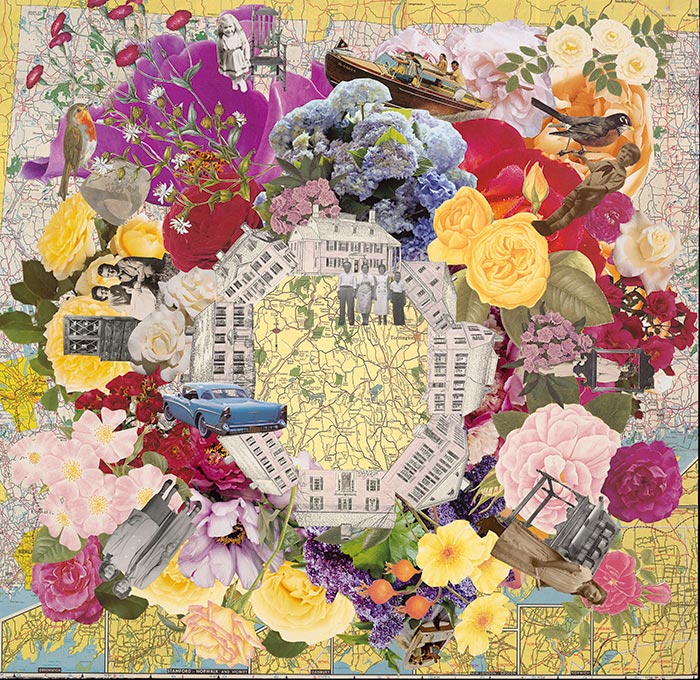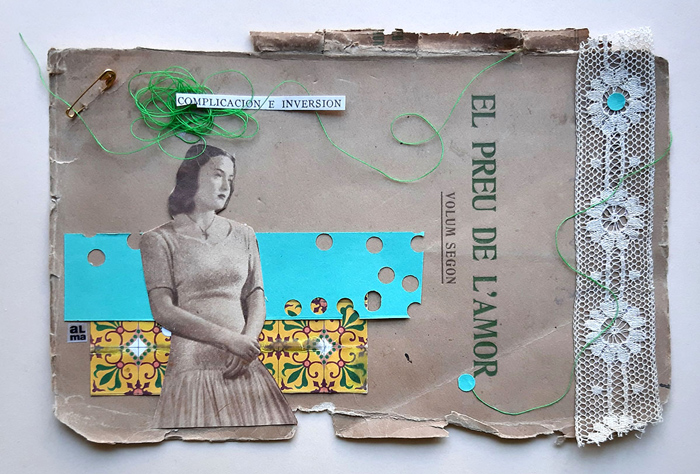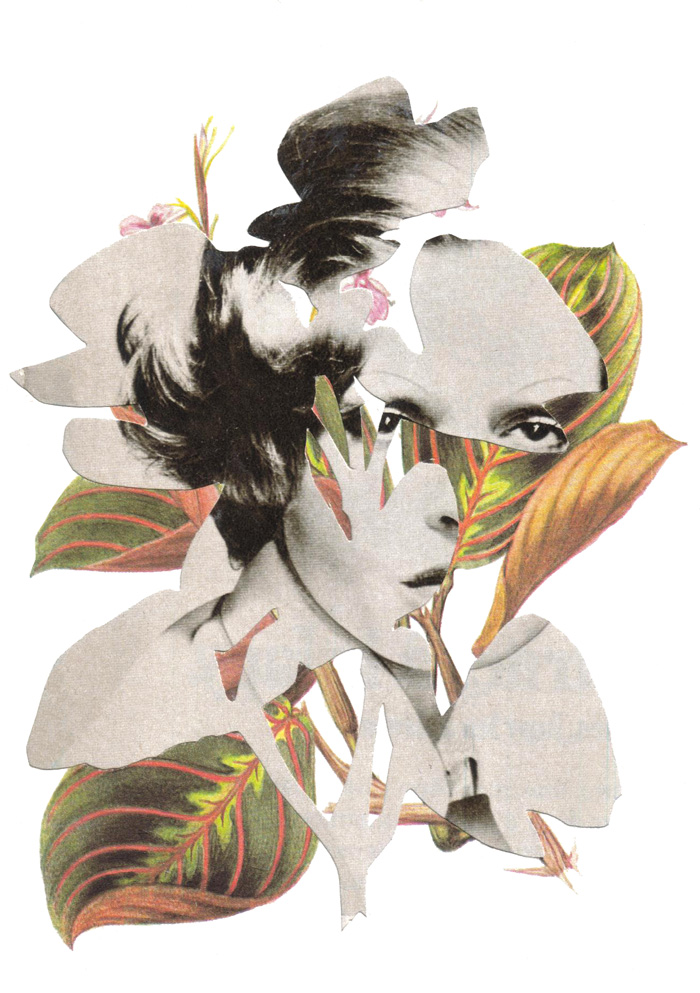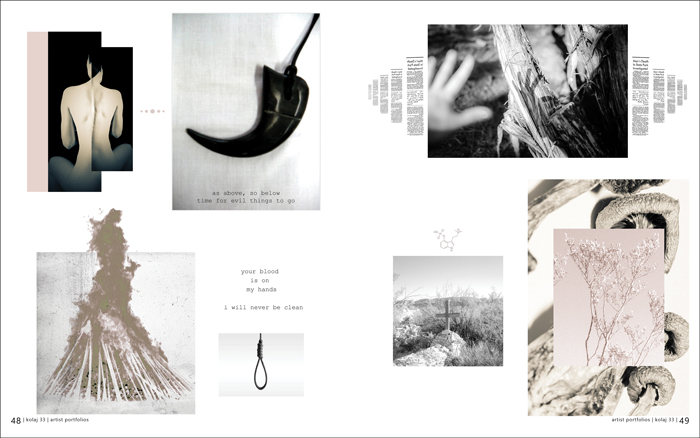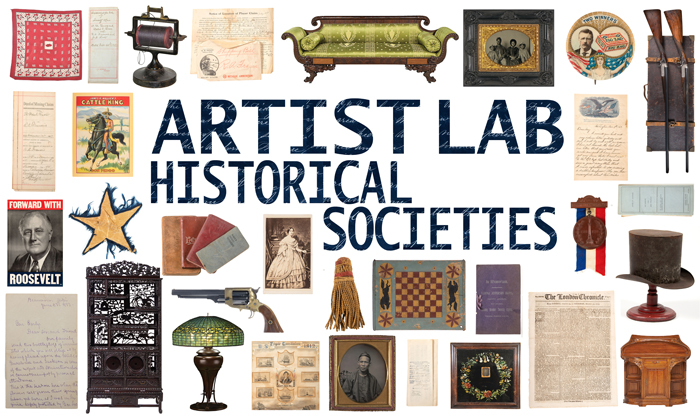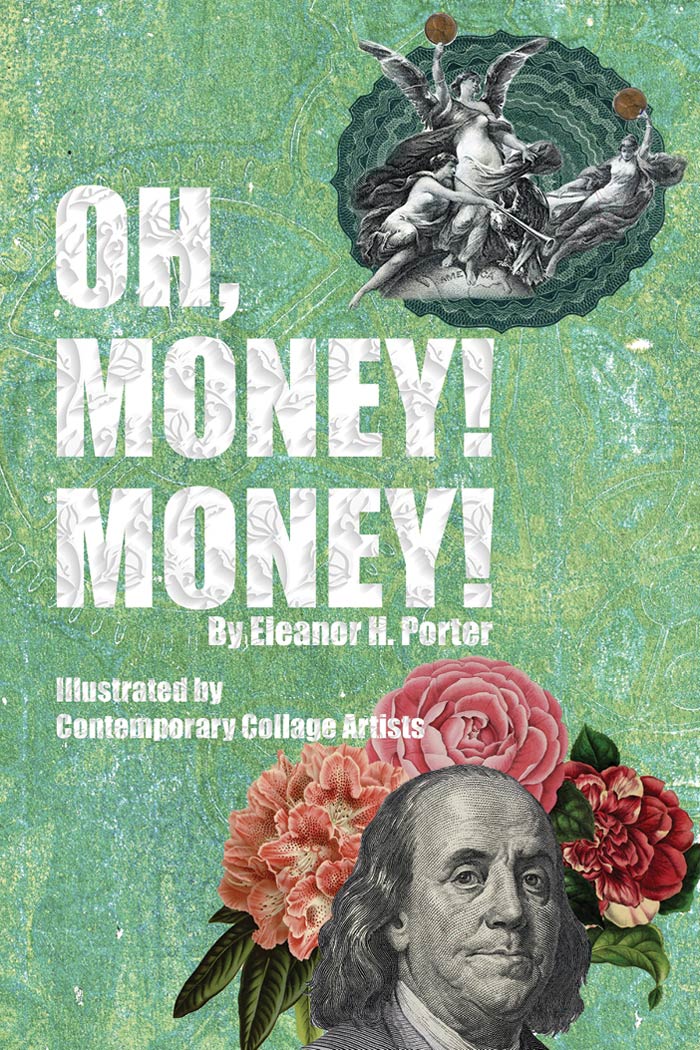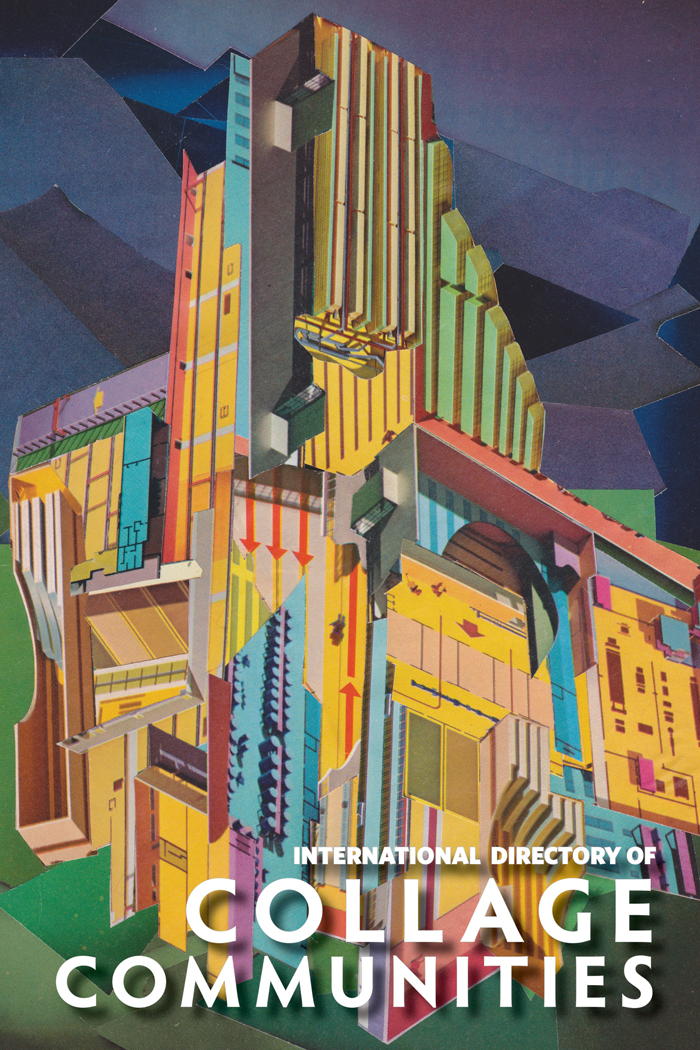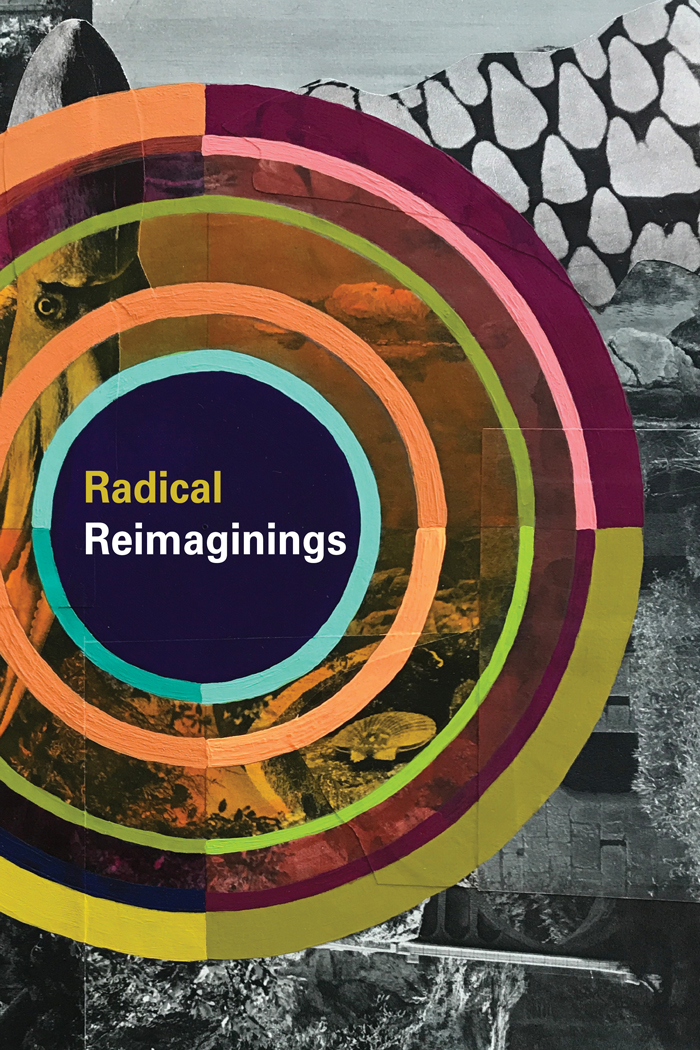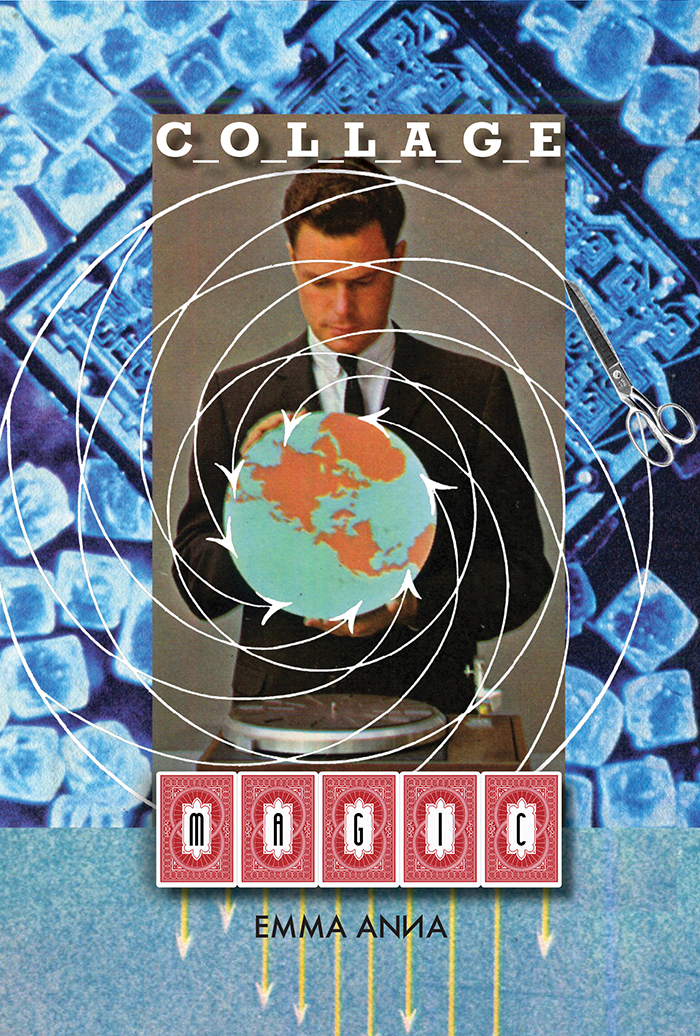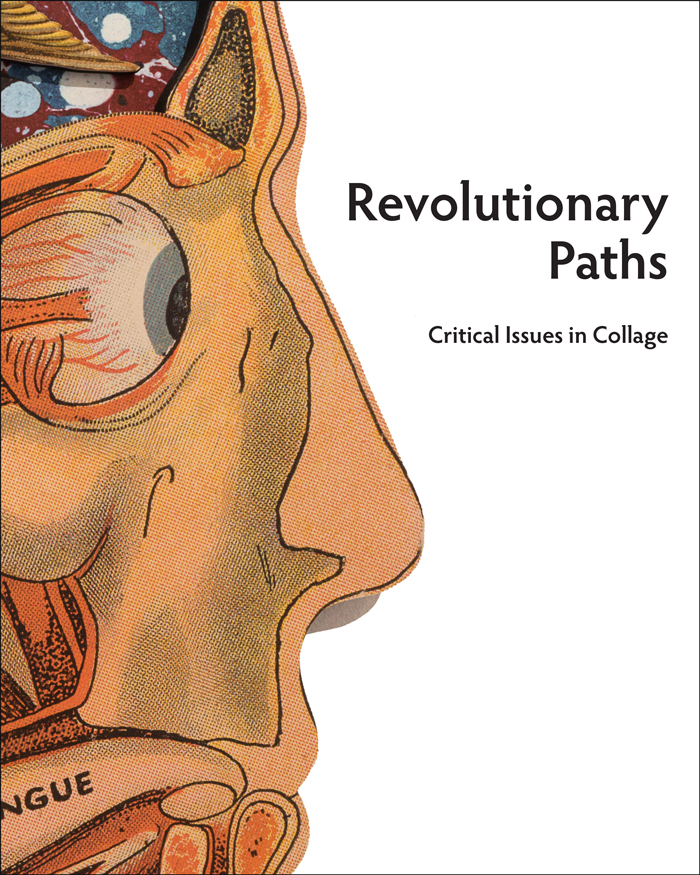![]()
MAGAZINE | INSTITUTE | CURRENT ISSUE | ARTIST DIRECTORY | SHOP
KOLAJ LIVE ONLINE | KOLAJ LIVE KNOXVILLE
FROM THE ARTIST DIRECTORY
The Beauty of the Unexpected
Cēsis, Latvia. In her work, Egija Zirapa uses mixed media–magazine and paper clippings, paint, pencil, ink. She mainly works with black-and-white portraits. "It is captivating, seeing how the paper cuttings, free colour dashes and fragments of photos become arranged, orchestrated by Egija’s hands, merging different worlds and starting to tell new and sensual stories." MORE
COLLAGE ON VIEW
Connect-To-Cut: Here, There and Everywhere
Susan Lerner at the Woodbury Public Library in Woodbury, Connecticut, USA through 30 September 2021. As a collage artist, Susan Lerner is intrigued by the physical and metaphorical connection of the map. How a map both literally and figuratively connects us to a place or a time from the past and brings us to the present. Using vintage imagery in hand-cut collages, she conjures up nostalgia for the county she has considered her second home for the past two decades. In this exhibit, she explores location and memories, often fictionalized, of now and then. MORE
FROM KOLAJ 33
Fog on the Glass
Lesley Schiff uses simple photocopy technology and found objects to make profoundly emotional work. Ghostly prints made with 1980s office machines anticipate our present day society, immersed in consumerism and tech culture. Katrina Slavik was part of Kolaj Institute’s Curating Collage Workshop that took place in Fall 2020. During that workshop, artists curated collage from the collection of the Fleming Museum of Art at the University of Vermont. Slavik got in touch with Schiff to speak to her about the 1981 series “Seasons” and her life and work as an artist since then. The full interview appears in Kolaj 33. MORE
FROM THE ARTIST DIRECTORY
Conceptual, Rich, & Powerful Visual Language
Barcelona, Spain. Alma Larroca believes in the image’s powerful and symbolic value to convey ideas. She researches combining techniques (analog and digital), to offer a visual response to the concept that needs to be communicated. She is especially interested in working on memory, the present that she builds from memories lived, learned, even forgotten. She makes assemblages and collages with materials that were previously discarded; by recycling them she re-signifies them in a new work, where in turn the observer discovers their own interpretation. MORE
COLLAGE BOOKS
Green Ladies
by Musta Fior. French Frog, 2021. Green Ladies presents a series of forty collages made from photos of women that accompanied advertisements or information in magazines from the 1940s through the 1980s. Most of these women are no doubt no longer with us. It was thus to pay homage to them by means of cuttings of plants as if nature began to take back its rights. It is also a reference to the illustrations of Jean-Jacques Grandville. MORE
COLLAGE ON VIEW
Stratum in Abstraction
Peggy Wright at Nevada City Winery in Nevada City, California, USA through 26 September 2021. Peggy Wright writes, "Strata are layers of material formed by natural or artificial means. Layering, as a concept and metaphor for the complexity of our world, attracted me as a broad concept to explore in this body of work. The list of substances that are formed in layers is long and varied. The earth, oceans, and forests are layered, as are bird feathers, ancient archeological sites and human skin. When I began to research and examine these subjects in detail, their distinct characteristics were revealed. Mixed media collage seemed the perfect medium for me to represent these unique characteristics." MORE
FROM KOLAJ 33
Reflection of Experiences
with Elements of Mysticism
“I only wanted to dream” by Michelle Concetta Parchini is a narrative project inspired by a traumatic event, the murder of the artist’s boyfriend. Working in the Curating Collage Workshop, iuri kothe proposes a conceptual installation that presents Parchini’s collage and video work in a ritualistic space, where the viewer removes their shoes and enters a candlelit room. Large collage prints lining the walls and a video installation playing in the rear of the room offer an intimate glimpse into the artist’s personal journey in dealing with the traumatic experience. Parchini's Artist Portfolio appears in Kolaj 33. MORE
Calls to Artists
Deadline: 26 September 2021
(click image for details)
Deadline: 26 September 2021
(click image for details)
Current Issue
Our goal with every issue is that Kolaj Magazine is essential reading for anyone interested in the role of contemporary collage in art, culture, and society. We not only hope you enjoy the articles and images in Kolaj #33, we hope it leads you to asking great questions.
PRINT MAGAZINE
Kolaj 33
Handling from “The Lives of Dahlias” series by Leslie Fry is on the cover of Kolaj 33. The blending of human, natural, and architectural motifs is a hallmark of Surrealism. Fry steps into this arena with a sword of feminist thinking and cuts through the dogma. Her work shows how Surrealism can reorient our thinking about nature. An article about her work appears in the issue.
Each issue of Kolaj Magazine shows how collage artists are making their way through the world. International in scope, we explore all aspects of collage and its impact on society and culture. MORE
Recent Publications
NEW BOOK
Oh, Money! Money!
by Eleanor H. Porter
Kolaj Institute is pleased to announce the publication of Oh, Money! Money!by Eleanor H. Porter and illustrated by a collective of collage artists. In Porter’s 1918 novel, a Chicago multi-millionaire struggles to decide to whom he should leave his money. The book is a time capsule of early 20th century American life with a strong focus on the lives of women and observations about material culture and communities before the rampant consumerism of the 1920s and the Great Depression. To illustrate the book, Kolaj Institute organized a residency that brought together ten artists who worked collaboratively to make sixty-three collages that interpret Porter’s novel for a 21st century audience. MORE

FROM ARTSHOP
Kolaj Year Eight Collectors Pack
NOW AVAILABLE! The Kolaj Magazine Year Eight Collectors Pack includes Issues 29, 30, 31, and 32. Our goal with every issue is that Kolaj Magazine is essential reading for anyone interested in the role of contemporary collage in art, culture, and society. MORE
BOOK
The Money $how: Cash, Labor, Capitalism & Collage
The Money $how juxtaposes contemporary artwork against fragments of history and literature as a way of showing how collage can help us deconstruct culture and understand the world differently. Artists collage dollar bills into flowers and mine material remnants to tell stories about home economics. MORE
SPECIAL EDITION
World Collage Day 2021
In honour of World Collage Day, May 8, 2021, Kolaj Magazine is releasing a special edition of the magazine. The Special Edition is full of Cut-Out Pages and stories from inspiring collage artists. MORE
Note: The World Collage Day Special Edition is not included in a regular Kolaj Magazine subscription.
COLLAGE BOOK
Unfamiliar Vegetables: Variations in Collage
Unfamiliar Vegetables is a collection of collage where each of the fifty artists interpreted, in their own way, Carlotta Bonnecaze’s 1892 Carnival float design Familiar Vegetables. Project organizer Christopher Kurts observed, “Unfamiliar Vegetables is an experiment in controlled chaos….tiny variations within each artist’s creative sphere accumulate until the outcomes are as unique as the people creating them.” MORE
COLLAGE COMMUNITIES
The International Directory of Collage Communities
The 104-page book is a survey of collage networks, guilds, communities, and projects as well as online efforts and groups focused on collage research. For each community, the directory presents their key activities, mission, how to join, and a bit of their history. Copious images illustrate the book. MORE
BOOK
Radical Reimaginings
The curators of the 96-page book invited artists who use collage in their practice to put forward a work of art that offers a visual narrative that speaks to the unprecedented change unfolding in 2020. An essay by Ric Kasini Kadour reflects upon collage's unique ability to imagine new realities. Forty artists from nine countries and multiple Indigenous peoples—Salish-Kootenai/Métis-Cree/Sho-Ban, Tlingit/Nisga’a, Oglala/Lakota, and Seneca Nation—offer a variety of perspectives. The voices of Black, Latinx, Native, and white Americans mingle with those from Chile, Colombia, Mexico, Peru, Argentina, Canada, France, and Germany. Artwork is accompanied by a statement in which the artists describe how they want to reimagine the world. MORE
BOOK
Collage Magic
by Emma Anna
Part autobiography, part fantasy, Emma Anna’s vision of The New Old World (aka The NOW) fuses vintage ephemera with modern imaging technologies. Emma shapes this strange world by using the pen tool from Adobe Photoshop as her magic wand, in the process declaring herself to be a “collage magician”. Part artist book, part document of art making, Collage Magic, from La Casa Verde Editions, is Emma Anna’s journey through magic and art. MORE
BOOK
Revolutionary Paths
When the collage is presented in exhibition, it is often done so without the critical framework granted other mediums. In "Revolutionary Paths: Critical Issues in Collage", exhibition curator Ric Kasini Kadour presents examples of collage that represent various aspects and takes on the medium. Each work in the exhibition represents the potential for deeper inquiry and further curatorial exploration of the medium. MORE
BOOK
Cultural Deconstructions
Collage is unique as a medium in that it uses as its material artifacts from the world itself. To harvest those fragments, the artist must first deconstruct culture; they must select, cut, and remove the elements they do not wish to use and then reconstruct work that tells a new story. In "Cultural Deconstructions: Critical Issues in Collage", exhibition curator Ric Kasini Kadour presents examples of collage artists who are deconstructing identity as a way to critique culture. MORE
Our goal with every issue is that Kolaj Magazine is essential reading for anyone interested in the role of contemporary collage in art, culture, and society. Each issue of Kolaj Magazine is dedicated to reviewing and surveying contemporary collage with an international perspective. We are interested in collage as a medium, a genre, a community, and a 21st century art movement.
